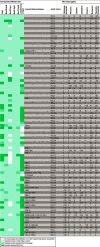Molecular Characterization of Baseline Enterobacterales and Pseudomonas aeruginosa Isolates from a Phase 3 Nosocomial Pneumonia (ASPECT-NP) Clinical Trial
- PMID: 33318005
- PMCID: PMC8092525
- DOI: 10.1128/AAC.02461-20
Molecular Characterization of Baseline Enterobacterales and Pseudomonas aeruginosa Isolates from a Phase 3 Nosocomial Pneumonia (ASPECT-NP) Clinical Trial
Abstract
We reviewed β-lactam-resistant baseline Enterobacterales species and Pseudomonas aeruginosa lower respiratory tract isolates collected during the ASPECT-NP phase 3 clinical trial that evaluated the safety and efficacy of ceftolozane-tazobactam compared with meropenem for the treatment of nosocomial pneumonia in ventilated adults. Isolates were subjected to whole-genome sequencing, real-time PCR for the quantification of the expression levels of β-lactamase and efflux pump genes, and Western blot analysis for the detection of OprD (P. aeruginosa only). Extended-spectrum β-lactamase (ESBL) genes were detected in 168 of 262 Enterobacterales isolates, and among these, blaCTX-M-15 was the most common, detected in 125 isolates. Sixty-one Enterobacterales isolates carried genes encoding carbapenemases, while 33 isolates did not carry ESBLs or carbapenemases. Carbapenemase-producing isolates carried mainly NDM and OXA-48 variants, with ceftolozane-tazobactam MIC values ranging from 4 to 128 µg/ml. Most ceftolozane-tazobactam-nonsusceptible Enterobacterales isolates that did not carry carbapenemases were Klebsiella pneumoniae isolates that exhibited disrupted OmpK35, specific mutations in OmpK36, and, in some isolates, elevated expression of blaCTX-M-15 Among 89 P. aeruginosa isolates, carbapenemases and ESBL-encoding genes were observed in 12 and 22 isolates, respectively. P. aeruginosa isolates without acquired β-lactamases displaying elevated expression of AmpC (14 isolates), elevated expression of efflux pumps (11 isolates), and/or a decrease or loss of OprD (22 isolates) were susceptible to ceftolozane-tazobactam. Ceftolozane-tazobactam was active against >75% of the Enterobacterales isolates from the ASPECT-NP trial that did not carry carbapenemases. K. pneumoniae strains resistant to ceftolozane-tazobactam might represent a challenge for treatment due to their multiple resistance mechanisms. Ceftolozane-tazobactam was among the agents that displayed the greatest activity against P. aeruginosa isolates. (This study has been registered at ClinicalTrials.gov under registration no. NCT02070757.).
Keywords: ceftolozane-tazobactam; clinical trial; β-lactam resistance.
Copyright © 2021 American Society for Microbiology.
Figures




References
-
- Melsen WG, Rovers MM, Groenwold RH, Bergmans DC, Camus C, Bauer TT, Hanisch EW, Klarin B, Koeman M, Krueger WA, Lacherade JC, Lorente L, Memish ZA, Morrow LE, Nardi G, van Nieuwenhoven CA, O'Keefe GE, Nakos G, Scannapieco FA, Seguin P, Staudinger T, Topeli A, Ferrer M, Bonten MJ. 2013. Attributable mortality of ventilator-associated pneumonia: a meta-analysis of individual patient data from randomised prevention studies. Lancet Infect Dis 13:665–671. doi:10.1016/S1473-3099(13)70081-1. - DOI - PubMed
-
- Magill SS, O’Leary E, Janelle SJ, Thompson DL, Dumyati G, Nadle J, Wilson LE, Kainer MA, Lynfield R, Greissman S, Ray SM, Beldavs Z, Gross C, Bamberg W, Sievers M, Concannon C, Buhr N, Warnke L, Maloney M, Ocampo V, Brooks J, Oyewumi T, Sharmin S, Richards K, Rainbow J, Samper M, Hancock EB, Leaptrot D, Scalise E, Badrun F, Phelps R, Edwards JR, Emerging Infections Program Hospital Prevalence Survey Team. 2018. Changes in prevalence of health care-associated infections in U.S. hospitals. N Engl J Med 379:1732–1744. doi:10.1056/NEJMoa1801550. - DOI - PMC - PubMed
Publication types
MeSH terms
Substances
Associated data
LinkOut - more resources
Full Text Sources
Other Literature Sources
Medical
Miscellaneous

